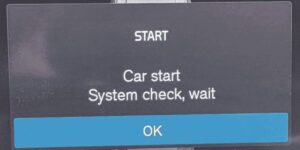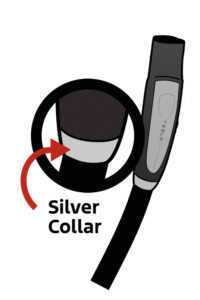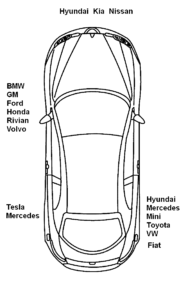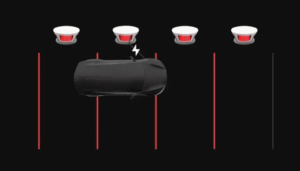On February 28, 2023 the Federal Highway Administration (FHWA) picked CCS as the type of DC fast charging plug that would receive $7½ billion in federal funding. After that, every US car maker and every provider of DC fast charging services announced that they would migrate to NACS (Tesla-style, also called J3400) charging plugs. Now the FHWA has requested comments as to whether the $7½ billion should continue to get spent on CCS plugs, or whether the money should go to J3400 plugs. As of today, 62 comments have been filed, nearly all of which say that the correct answer is “J3400”. One of the comments has a far higher word count than any of the others, and you can see it here, archived here.
Disappointing Hertz EV rental

Hertz did not cover itself in glory in a recent EV rental. The roadside assistance was clueless, the Hertz EV Trip Planner gave false information about charging locations, the charge-level-upon-return policy was customer-hostile, and the car that Hertz actually gave me had a shorter driving range than the car I had reserved. Continue reading “Disappointing Hertz EV rental”
Owners of Rivian EVs can now charge at Tesla supercharging stations
On June 20, 2023, Rivian announced (blog article) that Real Soon Now the owners of Rivian EVs would be able to charge at Tesla supercharging stations. Now, after a passage of more than eight months, there is progress.

Which vehicles does this apply to? The Rivian vehicles to which this applies to are the R1T pickup and R1S all-electric SUV. Each of these vehicles has a CCS1 charging port at the left front of the vehicle, behind the left front wheel. Each of these vehicles needs an adapter to be able to charge at a Tesla supercharging station. The adapter permits a Rivian EV with a CCS1 charging port to charge using a Tesla supercharger NACS (J3400) charging plug.
Avoiding incompatible Tesla superchargers. It turns out that only some Tesla superchargers can be used with this adapter for fast DC charging of Rivian EVs. The charging works only at (newer) V3 superchargers, and does not work at (older) V2 superchargers. (See this blog article that discusses the differences between V2 and V3 superchargers.) As a fun fact, one way that a person can figure out whether they are looking at a V2 or V3 supercharger is by looking at the charging plug.
| V2 supercharger | V3 supercharger | |
| works for Rivian EVs | no | yes |
 |
 |
As of right now (March 2024) the number of V3 charging kiosks in the US is about 15,000. For the owner of a Rivian CCS1 EV, the use of this adapter approximately doubles the number of places where the owner can accomplish fast DC charging.
This brings to two the number of makes of non-Tesla CCS1 EVs that can charge at NACS Tesla supercharging stations (see canonical list).
Where are the charging ports in US electric cars?

Yes, every US car maker has by now joined the NACS club (blog article). This means that Real Soon Now, they will drop the legacy CCS1 charging port and switch over to the NACS (Tesla-style) charging port. The natural corresponding step will be to place the charging port at either the left rear corner of the car or at the right front corner of the car. This location permits normal parking in a parking space in a Tesla supercharging station.
But Real Soon Now has not yet happened. As of right now, every newly manufactured EV by any US car maker that is not Tesla has a CCS1 charging port. Where on the vehicle do these non-Tesla car makers choose to place the (CCS1) charging port? I invited readers to respond to a survey on this. The diagram at above right shows the results of the survey. Continue reading “Where are the charging ports in US electric cars?”
Autocharge versus “plug and charge”
It turns out that there are better and worse ways to accomplish a seamless charging experience for fast DC charging of electric vehicles. There is “autocharge” which is older and more widely adopted, and less secure. EVgo uses “autocharge”. And there is “plug and charge” according to ISO 15118, which is much more secure, but is much newer and is not yet widely adopted. Continue reading “Autocharge versus “plug and charge””
Trying to enroll in EVgo’s “plug and charge” system
I have a table where I am trying to keep track of progress in the US toward “plug and charge”. It is quite discouraging to see so many cells that fail to say “yes”. Having said this, I figured I should try out EVgo’s “plug and charge” system, which it calls “Autocharge+“. It did not go well. Continue reading “Trying to enroll in EVgo’s “plug and charge” system”
What’s the correct list of vehicle makes supported by EVgo’s plug and charge?
EVgo’s web page about its “Autocharge” system (which means “plug and charge”) lists sixteen supported car makes. They are denoted in bold face in the table below.
What I learned is that that list of sixteen supported car makes is incomplete. A Rivian owner told me that Rivian is able to do plug and charge with EVgo.
Yesterday for the first time I managed to enroll my vehicle in EVgo’s plug and charge system. After that, I received a customer satisfaction survey from EVgo asking how this first charging session went. The first question is the make and model of the car that I charged. (The second question is the model year of the car.) The survey invited me to select the make and model from a drop-down list of 73 vehicle models. Doing a “view source” on the drop-down list revealed database codes that presumably get used internally in the analysis of the survey responses. The models and codes are listed in the table below.
It is interesting to speculate on why the database codes run in three distinct numerical sequences:
-
- nine digits starting with “7231244” (56 codes)
- nine digits starting with “8433858” (2 codes)
- nine digits starting with “9456995” (1 code)
- ten digits starting with “12650109” (10 codes)
What’s striking is how different the drop-down list is from the table on the EVgo web page. The main thing is that the drop-down list from the satisfaction survey is much longer — the survey includes vehicle makes that are missing from the EVgo web page:
-
- Audi
- BMW
- Fiat
- Fisker
- Harley-Davidson
- Honda
- Lordstown Endurance (Wikipedia article)
- Lucid
- Mazda
- Mini
- Mitsubishi
- Rivian
- Scion
- smart fortwo (Wikipedia article)
- Vinfast VF8 (Wikipedia article)
- Volkswagen
I welcome comments from readers who own any of the makes listed above, as to whether you have been able to enroll such an EV in EVgo’s Autocharge+ system.
Note that “Energica” is missing from the survey, despite being listed on the EVgo web page. What, you may ask, is “Energica”? It is a motorcycle.
| Make and model | database code |
| Audi e-tron | 723124418 |
| Audi e-tron GT | 723124419 |
| Audi e-tron Sportback | 723124420 |
| BMW Active E | 723124421 |
| BMW i3 | 723124422 |
| BMW i4 | 1265010945 |
| BMW i5 | 945699583 |
| BMW i7 | 723124423 |
| BMW iX | 723124424 |
| Cadillac Lyriq | 1265010946 |
| Chevrolet Blazer EV | 723124425 |
| Chevrolet Bolt EUV | 723124426 |
| Chevrolet Bolt EV | 723124427 |
| Chevrolet Spark EV | 723124428 |
| Energica Experia | |
| Energica Eva Ribelle | |
| Energica Ego | |
| Energica EsseEsse9 | |
| Fiat 500e | 1265010947 |
| Fisker Ocean | 723124429 |
| Ford E-Transit-350 Cargo | 723124430 |
| Ford F-150 Lightning | 723124431 |
| Ford Focus Electric | 723124432 |
| Ford Mustang Mach-E | 1265010949 |
| Genesis Electrified G80 | 723124433 |
| Genesis GV60 | 1265010948 |
| Genesis GV70 | 723124434 |
| GMC Hummer EV | 723124435 |
| Harley-Davison LiveWire | 723124436 |
| Honda Clarity EV | 723124437 |
| Honda Fit EV | 723124438 |
| Hyundai Ioniq 5 | 1265010950 |
| Hyundai Ioniq 6 | 723124439 |
| Hyundai Ioniq Electric | 723124440 |
| Hyundai Kona Electric | 723124441 |
| Jaguar I-Pace | 723124442 |
| Kia EV6 | 1265010951 |
| Kia EV9 | 723124443 |
| Kia Niro Electric | 723124444 |
| Kia Soul Electric | 1265010952 |
| Lexus RZ 450e | 843385879 |
| Lordstown Endurance | 723124445 |
| Lucid Air | 723124446 |
| Mazda MX-30 | 723124448 |
| Mercedes-Benz B-Class Electric Drive | 723124447 |
| Mercedes-Benz B250e | 1265010953 |
| Mercedes-Benz EQB | 1265010954 |
| Mercedes-Benz EQE | 723124449 |
| Mercedes-Benz EQS | 723124450 |
| MINI Cooper SE | 723124451 |
| MINI Electric | 723124452 |
| Mitsubishi i-MiEV | 723124453 |
| Nissan Ariya | 723124454 |
| Nissan Leaf | 723124455 |
| Nissan Leaf Plus | 723124456 |
| Polestar 2 | 723124457 |
| Porsche Taycan | 723124458 |
| Rivian R1S | 723124459 |
| Rivian R1T | 723124460 |
| Scion iQ EV | 723124461 |
| smart fortwo | 723124462 |
| Subaru Solterra | 723124463 |
| Tesla Model 3 | 723124464 |
| Tesla Model S | 723124465 |
| Tesla Model X | 723124466 |
| Tesla Model Y | 723124467 |
| Toyota bZ4x | 723124468 |
| Toyota RAV4 EV | 843385880 |
| VinFast VF8 | 723124469 |
| Volkswagen e-Golf | 723124470 |
| Volkswagen ID.4 | 723124471 |
| Volvo C40 Recharge | 723124472 |
| Volvo XC40 Recharge | 723124473 |
Comparing coverage of Electrify America and EVgo and Tesla
Let’s suppose you are going to fly to Dulles, rent an EV, and drive to Charlottesville, VA. How do three major EV-charging service providers compare for geographic coverage along this route? Continue reading “Comparing coverage of Electrify America and EVgo and Tesla”
Who gets to do an easy “plug and charge”?
(Update: what “plug and charge” charging experiences are available in the US? I have set up a table that I hope will show progress with setting up “plug and charge” in the US.)
From the moment that became an owner of a Tesla vehicle, I was able to do an easy “plug and charge”. I would park my car at a Tesla charging kiosk, plug the charging plug of the kiosk into the charging port of the car, and charging would commence.
Note what is missing from the previous sentence. Never in all of my years of charging my Tesla car at a Tesla charging station have I needed to do anything else to get the charging to commence. No tapping a proximity card in front of a “tap to pay” reader on the kiosk. No tapping a credit card in front of a “tap to pay” reader on the kiosk. No waving my phone in front of a “tap to pay” reader on the kiosk. No inserting a credit card into a credit card reader on the kiosk. No fumbling with a smart phone app, and no cursing because the stupid smart phone app had logged me out and of course I do not have the password memorized for logging back in. No going on a treasure hunt on the kiosk to try to work out what the “kiosk number” is so that I can key in the kiosk number at the smart phone app. No calling up tech support to talk to somebody about why the “tap to pay” did not work.
Tesla owners are, as you may appreciate, rather spoiled by this absolutely seamless charging experience. We read news stories about owners of non-Tesla vehicles who end up very disappointed or angry because when they finally did locate a non-broken charging kiosk, they found that it was difficult or impossible to get the actual charging to begin. Or if it was not that bad, at least the owner of the non-Tesla vehicle had to tap a phone or tap a prox card or key in a kiosk number into a smart phone app, to get charging to commence. Yes, we read those news stories, but having never had those problems, we do not fully appreciate how bad it might be to try to get charging to commence.
Across the US are tens of thousands of free-of-charge Level 2 chargers. Most of them provide a seamless charging experience, but of course it is slow. You might have to leave your vehicle at the charger overnight to get a full charge. No, what I am talking about in this blog article is fast DC charging or “supercharging”, typically at speeds of 50 kW or 150 kW or more.
Which brings me to two general questions. First, to what extent is there any way for a Tesla owner to have “plug and charge” fast DC charging experience on any non-Tesla-branded kiosk? And second, to what extent does the owner of a non-Tesla EV ever get to have a “plug and charge” fast DC charging experience? Continue reading “Who gets to do an easy “plug and charge”?”
Owners of Ford EVs can now charge at Tesla supercharging stations

The subject line of this blog article makes things sound better than they are. The real situation is that starting now, the owner of a Ford CCS1 EV can try to place an order for an adapter to be able to charge at Tesla supercharging stations. If and when the owner successfully places the order for the adapter, the owner gets to wait for the adapter to arrive. If and when the adapter arrives, the owner can try to find a Tesla supercharging station at which the charging can be carried out. When the time comes to plug in the Ford CCS1 EV at the Tesla supercharging station, it is likely this will greatly inconvenience other users of the supercharging station. Continue reading “Owners of Ford EVs can now charge at Tesla supercharging stations”